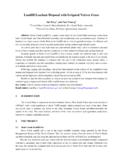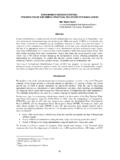Transcription of Vetiver system ecotechnology for water quality …
1 NEWS CURRENT SCIENCE, VOL. 86, NO. 1, 10 JANUARY 2004 11 MEETING REPORT Vetiver system ecotechnology for water quality improvement and environmental enhancementVetiver, Vetiveria zizanioides L. Nash, a native grass of India has traditionally been in use in India for contour protec-tion and essential-oil production. Taking clues from its traditional usage in envi-ronmental protection, The World Bank initiated several projects in India in 1980s for systematic development of Vetiver Grass Technology (VGT), now popularly known as Vetiver system (VS). Large-scale developments have since taken place in the advancement of VS in environmental protection1; new avenues have opened up over the past 15 years2.
2 The VS is emerging as a panacea to a host of environmental problems. It is a low cost, extremely effective system that offers proven solutions for soil and water conservation, wastewater treatment, em-bankment stabilization, flood control, disaster and pollution mitigation, agro-forestry management, and many other environment-friendly applications being used in over 100 countries3. The VS for wastewater treatment is a new and inno-vative phyto-remedial eco-technology, which has the potential to meet all the right criteria necessary for environmental enhancement. It is a natural, green, sim-ple, practicable and cost-effective solu-tion, and its by-products offer a range of uses in handicrafts, animal feed, fuel and construction applications.
3 Morphological and physiological attributes of Vetiver grass, its strong, deep penetrating (Figure 1 a), aerenchymatous (Figure 1 b) root system , unusual ability to absorb and tolerate extreme levels of nutrients, agro-chemicals and heavy metals make it an ideal system for environmental enhance-ment through appropriate interventions in the treatment regime. The 3rd International Conference on Vetiver and Exhibition (ICV-3), was orga-nized in Guangzhou, China during 6 9 October 2003 by the Guangdong Academy of Agricultural Sciences, in association with South China Institute of Botany (Chinese Academy of Sciences), South China Agricultural University and Guang-dong Association of Grass Industry and Environment.
4 The theme of the confer-ence Vetiver and water was truly em-bodied in the conference deliberations, highlighting that Vetiver (i) is native to hygro-environment such as wetland, lagoon and bog, (ii) is extremely tolerant to drought as well as waterlogged/ submergence conditions, (iii) is effective for soil and water conservation, and (iv) is endowed with excellent biological features to ameliorate wastewater and pollution mitigation. The conference was inaugurated by the Patron of The Vetiver Network, HRH Princess Maha Chakri Sirindhorn of Thailand, and was attended by over 230 delegates representing 28 countries. There were 13 plenary presen-tations covering eight sub-themes, and 46 oral presentations, including four King of Thailand Vetiver Award presentations4.
5 Also, an exhibition on VS-based eco-technologies and products in the form of posters and demonstration stalls was arranged at the conference site by vari-ous scientific agencies and entrepre-neurs. Further, the organizers had also arranged a one-day study tour for an on-site live demonstration of VS projects ranging from applications of Vetiver in garbage landfill site management, land slope stabilization and slope aforestation, and water and vegetation rehabilitation at an ecological park. Sumit Tantivejkul, Secretary General, Chaipattana Foundation, Bangkok in his keynote address on Thailand s experience with respect to Vetiver and water , under-pinned the significance of Vetiver grass for its deep penetrating root system that forms an underground wall barrier and helps to filter silt and maintain topsoil.
6 He stressed that exhaustive experimenta-tion on Vetiver system covering over 30 initiatives by the Royal Development Study Centres has since been imple-mented all over Thailand by the Gov-ernmental agencies for realization of bene-fits of Vetiver system in soil and water conservation, forest rehabilitation and restoration of degraded soil, as well as environmental protection of water bodies from effluent contamination and garbage decomposition. John Greenfield (New Zealand) giving a historical perspective of Advance of scientific research on Vetiver system traced the rediscovery of the versatile VS, from realization of Vetiver hedges to mark out farm bounda-ries in Karnataka (India), to the World Bank-supported follow-up studies on grass biodiversity vis- -vis its multifari-ous applications in phyto-remediation, reclamation of mine dumps, and its abil-ity to filter toxins before they enter the water -table.
7 In his opening lecture Vetiver grass a world technology and its impact on water Richard G. Grimshaw (USA) des-cribed how Vetiver has developed as a world technology over four phases of application: soil and water conservation in poor rural areas; infrastructure stabili-zation; rehabilitation of difficult and often polluted sites; and water quality enhancement and site rehabilitation in relation to industry and intensive agricul-ture. He admitted that introduction of VS-based new technology was slow, but it has since made steady progress. Paul Truong (Australia) in his talk on Vetiver system for water quality imp-rovement , dwelt upon the significance of the VS in addressing the imminent global crisis of water shortage.
8 Pinpoint-ing the ability of Vetiver grass to with-stand highly adverse climatic and edaphic conditions, including elevated levels of salt, acidity, alkalinity, sodicity as well as a whole range of heavy metals, and also its ability to absorb and tolerate extreme levels of nutrients, he advocated that Vetiver is ideally suited for treating contaminated and polluted wastewater from industries as well as domestic dis-charge. Highlighting morphological and physiological attributes of Vetiver sup-ported with empirical observations, he emphasized that the VS can help manage wastewater quantity through seepage control, and its quality by trapping sedi-ments and particles, tolerating and absor-bing pollutants, heavy metals, and deto-xification and breakdown of industrial, mining and agrochemical residues, dur-ing land irrigation and under wetland conditions.
9 Through another presenta-tion he pointed out that Vetiver , on ac-count of its trapping/absorption capacity of nutrients, sediments and agrochemi-cals, can help stabilize otherwise fragile drain banks made up of acid sulphate NEWS CURRENT SCIENCE, VOL. 86, NO. 1, 10 JANUARY 2004 12 Figure 1. Eco-technological applications of the Vetiver system . a, A m long fibrous root system after 275 days of growth, from China, b, Transverse section of mature root showing schizogenous aerenchymatous cortex suitable for waterlogged condition and well-developed phloem for essential oil. c, Garbage landfill site in China covered with thick rubber sheet on top and earthen slope planted with Vetiver for slope stabilization and leachate absorption.
10 D, Slide-slope protection by Vetiver along the railway line in Madagascar proper drainage and suitable agroforestry for sustainable utilization of the Vetiver system . e, Tea bushes grown between Vetiver hedge rows in China to advance tea growth and tea quality . f and g, Restoration of water channel in the ecological park contaminated wastewater channel (f) and ecologically restored water channel after Vetiver plantation (g). h, Natural water ponds near Lucknow. (Below) With eutrophicated water having algal bloom. (Top) With Vetiver purified water supported with green vegetation. i, Vetiver floating pontoons for wastewater treatment in a sewerage pond in Australia. a b c e d f h g i NEWS CURRENT SCIENCE, VOL.










